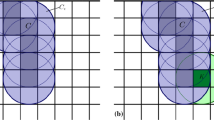Abstract
In the present work, the corrected extended finite element method (XFEM) is extended to conduct fatigue analysis of arbitrary crack growth in ductile materials. In corrected XFEM, the crack is modeled by adding enrichment functions into the approximation; optimal convergence rate and independent mesh discretization can be achieved, and the re-meshing and refinement during crack evolving can be avoided. von Mises yield criterion along with isotropic hardening is used to model finite strain plasticity. The nonlinear problem is solved by Newton–Raphson iterative method. Interaction integral method is employed to calculate mixed-mode stress intensity factors. Crack growth angle and rate are determined by the maximum principal stress criterion and the modified Paris law, respectively. Two problems, i.e., ductile crack growth in round compact tension specimen and ductile crack growth in overhanging beam are presented. The numerical results are compared with experimental data as well as FE simulation, to demonstrate the excellent capability of XFEM for simulating arbitrary crack growth in ductile materials.















Similar content being viewed by others
References
Weng TL, Sun CT (2000) A study of fracture criteria for ductile materials. Eng Fail Anal 7(2):101–125
Nikishkov G (2013) Accuracy of quarter-point element in modeling crack-tip fields. CMES Comp Model Eng 93(5):335–361
Miranda ACO, Meggiolaro MA, Castro JTP, Martha LF (2003) Fatigue life prediction of complex 2D components under mixed-mode variable amplitude loading. Int J Fatigue 25(9–11):1157–1167
Meggiolaro MA, Miranda ACO, Castro JTP, Martha LF (2005) Crack retardation equations for the propagation of branched fatigue cracks. Int J Fatigue 27(10–12):1398–1407
Meggiolaro MA, Miranda ACO, Castro JTP, Martha LF (2005) Stress intensity factor equations for branched crack growth. Eng Fract Mech 72(17):2647–2671
Portela AA, Aliabadi M, Rooke D (1991) The dual boundary element method effective implementation for crack problems. Int J Numer Meth Eng 33:269–1287
Leonel ED, Chateauneuf A, Venturini WS (2012) Probabilistic crack growth analyses using a boundary element model: applications in linear elastic fracture and fatigue problems. Eng Anal Bound Elem 36(6):944–959
Yan X (2006) A boundary element modeling of fatigue crack growth in a plane elastic plate. Mech Res Commun 33(4):470–481
Belytschko T, Gu L, Lu YY (1994) Fracture and crack growth by element free Galerkin methods. Model Simul Mater Sci 2:519
Belytschko T, Lu YY, Gu L (1995) Crack propagation by element-free Galerkin methods. Eng Fract Mech 51(2):295–315
Dai KY, Liu GR, Lim KM, Han X, Du SY (2004) A meshfree radial point interpolation method for analysis of functionally graded material (FGM) plates. Comput Mech 34(3):213–223
Tal Y, Hatzor YH, Feng X (2014) An improved numerical manifold method for simulation of sequential excavation in fractured rocks. Int J Rock Mech Min 65:116–128
Belytschko T, Black T (1999) Elastic crack growth in finite elements with minimal remeshing. Int J Numer Meth Eng 45(5):601–620
Daux C, Mos N, Dolbow J, Sukumar N, Belytschko T (2000) Arbitrary branched and intersecting cracks with the extended finite element method. Int J Numer Meth Eng 48:1741–1760
Fries TP (2008) A corrected XFEM approximation without problems in blending elements. Int J Numer Meth Eng 75(5):503–532
Unger JF, Eckardt S, Könke C (2007) Modelling of cohesive crack growth in concrete structures with the extended finite element method. Comput Method Appl Mech 196(41–44):4087–4100
Moës N, Belytschko T (2002) Extended finite element method for cohesive crack growth. Eng Fract Mech 69(7):813–833
Khoei AR, Nikbakht M (2006) Contact friction modeling with the extended finite element method (X-FEM). J Mater Process Tech 177(1–3):58–62
Khoei AR, Nikbakht M (2007) An enriched finite element algorithm for numerical computation of contact friction problems. Int J Mech Sci 49(2):183–199
Liu ZL, Menouillard T, Belytschko T (2011) An XFEM/Spectral element method for dynamic crack propagation. Int J Fracture 169(2):183–198
Sukumar N, Mo SN, Moran B, Belytschko T (2000) Extended finite element method for three-dimensional crack modelling. Int J Numer Meth Eng 48(11):1549–1570
Yu TT, Gong ZW (2013) Numerical simulation of temperature field in heterogeneous material with the XFEM. Arch Civ Mech Eng 13(2):199–208
Zienkiewicz OC, Taylor RL, Zhu JZ (2005) The finite element method, 6th edn, Butterworth-Heinemann, Buston, USA
Jovicic G, Zivkovic M, Jovicic N, Milovanovic D, Sedmak A (2010) Improvement of algorithm for numerical crack modelling. Arch Civ Mech Eng 10(3):19–35
Elguedj T, Gravouil A, Combescure A (2006) Appropriate extended functions for X-FEM simulation of plastic fracture mechanics. Comput Method Appl Mech 195(7–8):501–515
Seabra MRR, Šuštarič P, Cesar De Sa JMA, Rodič T (2013) Damage driven crack initiation and propagation in ductile metals using XFEM. Comput Mech 52(1):161–179
Shedbale AS, Singh IV, Mishra BK (2013) Nonlinear simulation of an embedded crack in the presence of holes and inclusions by XFEM. Procedia Eng 64:642–651
Kumar S, Singh IV, Mishra BK (2014) XFEM simulation of stable crack growth using J–R curve under finite strain plasticity. Int J Mech Mater Des 10(2):165–177
Miranda ACO, Meggiolaro MA, Martha LF, Castro JTP (2012) Stress intensity factor predictions: comparison and round-off error. Comp Mater Sci 53(1):354–358
Singh IV, Bhardwaj G, Mishra BK (2015) A new criterion for modeling multiple discontinuities passing through an element using XIGA. J Mech Sci Technol 29(3):1131–1143
Huang X, Torgeir M, Cui W (2008) An engineering model of fatigue crack growth under variable amplitude loading. Int J Fatigue 30(1):2–10
Singh IV, Mishra BK, Bhattacharya S, Patil RU (2012) The numerical simulation of fatigue crack growth using extended finite element method. Int J Fatigue 36(1):109–119
Moës N, Dolbow J, Belytschko T (1999) A finite element method for crack growth without remeshing. Int J Numer Meth Eng 46:131–150
ASTM B 209 (2007) Standard specification for aluminum and aluminum-alloy sheet and plate. ASTM committee
Wang C, Wang X, Ding Z, Xu Y, Gao Z (2015) Experimental investigation and numerical prediction of fatigue crack growth of 2024-T4 aluminum alloy. Int J Fatigue 78:11–21
Acknowledgments
The authors gratefully acknowledge the supports from the National Natural Science Foundation of China (Nos. 51278297 and 11172174) and the Major Program of the National Natural Science Foundation of China (No. 51490674), Research Program of Shanghai Leader Talent(No. 20)and Doctoral Disciplinary Special Research Project of Chinese Ministry of Education (No. 20130073110096).
Author information
Authors and Affiliations
Corresponding author
Additional information
Technical Editor: Marcelo A. Savi.
Rights and permissions
About this article
Cite this article
Liu, G., Zhou, D., Ma, J. et al. Numerical investigation of mixed-mode crack growth in ductile material using elastic–plastic XFEM. J Braz. Soc. Mech. Sci. Eng. 38, 1689–1699 (2016). https://doi.org/10.1007/s40430-016-0557-z
Received:
Accepted:
Published:
Issue Date:
DOI: https://doi.org/10.1007/s40430-016-0557-z




